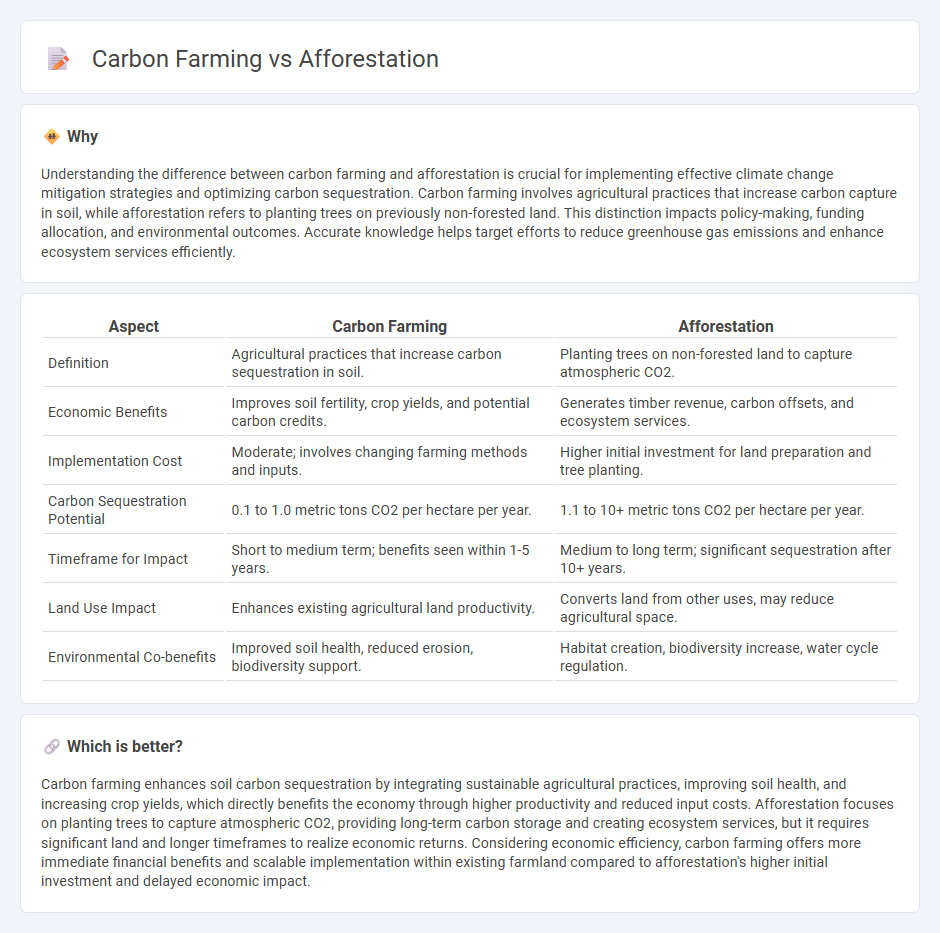
Carbon farming involves agricultural practices aimed at capturing atmospheric carbon dioxide and storing it in soil and vegetation, enhancing soil health and reducing greenhouse gases. Afforestation refers to planting trees on previously non-forested land to absorb carbon dioxide and create new forest ecosystems, contributing to biodiversity and climate mitigation. Explore the economic impacts and benefits of both carbon farming and afforestation to understand their roles in sustainable development.
Why it is important
Understanding the difference between carbon farming and afforestation is crucial for implementing effective climate change mitigation strategies and optimizing carbon sequestration. Carbon farming involves agricultural practices that increase carbon capture in soil, while afforestation refers to planting trees on previously non-forested land. This distinction impacts policy-making, funding allocation, and environmental outcomes. Accurate knowledge helps target efforts to reduce greenhouse gas emissions and enhance ecosystem services efficiently.
Comparison Table
| Aspect | Carbon Farming | Afforestation |
|---|---|---|
| Definition | Agricultural practices that increase carbon sequestration in soil. | Planting trees on non-forested land to capture atmospheric CO2. |
| Economic Benefits | Improves soil fertility, crop yields, and potential carbon credits. | Generates timber revenue, carbon offsets, and ecosystem services. |
| Implementation Cost | Moderate; involves changing farming methods and inputs. | Higher initial investment for land preparation and tree planting. |
| Carbon Sequestration Potential | 0.1 to 1.0 metric tons CO2 per hectare per year. | 1.1 to 10+ metric tons CO2 per hectare per year. |
| Timeframe for Impact | Short to medium term; benefits seen within 1-5 years. | Medium to long term; significant sequestration after 10+ years. |
| Land Use Impact | Enhances existing agricultural land productivity. | Converts land from other uses, may reduce agricultural space. |
| Environmental Co-benefits | Improved soil health, reduced erosion, biodiversity support. | Habitat creation, biodiversity increase, water cycle regulation. |
Which is better?
Carbon farming enhances soil carbon sequestration by integrating sustainable agricultural practices, improving soil health, and increasing crop yields, which directly benefits the economy through higher productivity and reduced input costs. Afforestation focuses on planting trees to capture atmospheric CO2, providing long-term carbon storage and creating ecosystem services, but it requires significant land and longer timeframes to realize economic returns. Considering economic efficiency, carbon farming offers more immediate financial benefits and scalable implementation within existing farmland compared to afforestation's higher initial investment and delayed economic impact.
Connection
Carbon farming and afforestation are interconnected strategies that enhance carbon sequestration to mitigate climate change impacts on the economy. By increasing biomass through tree planting and improved land management, these practices reduce atmospheric CO2 levels, supporting sustainable agricultural productivity and generating carbon credits. This integration promotes economic resilience by diversifying income sources for farmers and fostering green investments.
Key Terms
Carbon Credits
Afforestation involves planting trees to capture carbon dioxide, creating carbon sinks that contribute to carbon credit generation by sequestering atmospheric CO2 over time. Carbon farming encompasses a range of agricultural practices, such as cover cropping and soil amendment, designed to enhance soil carbon storage and improve carbon credit eligibility through verified greenhouse gas reductions. Explore detailed comparisons of carbon credit mechanisms and project eligibility criteria to optimize environmental impact and economic returns.
Ecosystem Services
Afforestation enhances ecosystem services by increasing biodiversity, improving soil quality, and regulating water cycles through the establishment of new forested areas. Carbon farming focuses on sequestering atmospheric carbon in soil and vegetation, boosting soil health, and supporting sustainable agricultural practices that benefit ecosystem resilience. Explore how these strategies complement each other to optimize environmental benefits and climate mitigation efforts.
Green Finance
Afforestation involves planting trees on non-forested land to sequester carbon dioxide, contributing significantly to climate change mitigation through enhanced carbon stocks and biodiversity gains. Carbon farming employs agricultural practices such as cover cropping and soil carbon enhancement to capture atmospheric CO2 while improving soil health and farm resilience. Explore how green finance mechanisms are driving investments in both afforestation and carbon farming projects to support sustainable environmental and economic outcomes.
Source and External Links
Afforestation - UN-REDD Glossary - Afforestation is the direct human-induced conversion of land that has not been forested for at least 50 years into forested land through planting, seeding, or promoting natural regeneration.
Afforestation - Climate Impact - Afforestation involves selecting a suitable site, choosing appropriate tree species, planting, maintaining, and monitoring the growth of new forests where they did not previously exist.
Afforestation - Wikipedia - Afforestation provides benefits such as carbon sequestration, soil erosion prevention, biodiversity support, improved air and water quality, and employment opportunities.
 dowidth.com
dowidth.com